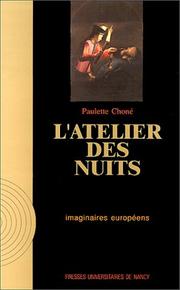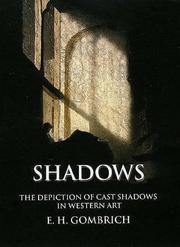| Listing 1 - 3 of 3 |
Sort by
|

ISBN: 2864806134 9782864806134 Year: 1992 Publisher: Nancy Presses Universitaires de Nancy
Abstract | Keywords | Export | Availability | Bookmark
 Loading...
Loading...Choose an application
- Reference Manager
- EndNote
- RefWorks (Direct export to RefWorks)
night --- Iconography --- Light in art --- Night in art --- Art, Renaissance --- Art, Modern --- Shades and shadows in art. --- Lumière dans l'art --- Nuit dans l'art --- Art de la Renaissance --- Art --- Ombres dans l'art --- Themes, motives --- Thèmes, motifs --- Lumière dans l'art --- Thèmes, motifs --- Themes, motives. --- CDL --- 7.034 --- Shades and shadows in art --- Chiaroscuro --- Shades and shadows --- Light and shade --- Shade --- Shadows --- Geometry, Descriptive --- Perspective --- Clairobscur --- Color prints --- Painting --- Modern art --- Nieuwe Ploeg (Group of artists) --- Art, Occidental --- Art, Visual --- Art, Western (Western countries) --- Arts, Fine --- Arts, Visual --- Fine arts --- Occidental art --- Visual arts --- Western art (Western countries) --- Arts --- Aesthetics --- Light and darkness in art --- Technique --- Art, Primitive --- nachtstuk

ISBN: 0300063571 9780300063578 1857090918 9781857090918 Year: 1995 Publisher: London National Gallery Publications
Abstract | Keywords | Export | Availability | Bookmark
 Loading...
Loading...Choose an application
- Reference Manager
- EndNote
- RefWorks (Direct export to RefWorks)
Cast shadows have been exploited in art to enhance the impression of the surrounding light as well as that of the solidity of the casting objects. They can contribute to the mood of the scene, and can reveal the presence of features outside the space represented, but as Professor Gombrich points out, they appear only sporadicaly and have been more frequently ignored or suppressed in Western art. Gombrich touches on the ambiguous nature of shadows in myth, legend, and philosophy, and briefly analyses the factors governing their shape: the location and form of the light source, the shape of the illuminated object and that of the surface on which the shadow falls, and the position of the viewer. Early Renaissance painters such as Masaccio and Campin, intent on a faithful rendering of visual reality, did incorporate shadows in their art, but artists of Leonardo's time largely avoided painting them, and it was not until early in the seventeenth century that painters - particualrly Caravaggio and Rembrandt - were again interested in the effects of shadows. In subsequent centuries artists of the Romantic, Impressionist and Surrealist movements exploited the device of the cast shadow to enhance the realism or drama of their images.
Art
---
shadows
---
National Gallery [London]
---
Shades and shadows in art
---
Exhibitions
---
Painting [European ]
---
Kunst
---
schaduwen
---
National Gallery [Londen]
---
CDL
---
7.03
---
Visual perception
---
Paintings.
---
742.5
---
7.017.9
---
#BIBC:ruil
Book
ISBN: 9782503549446 2503549446 Year: 2014 Volume: *6 Publisher: Turnhout Brepols
Abstract | Keywords | Export | Availability | Bookmark
 Loading...
Loading...Choose an application
- Reference Manager
- EndNote
- RefWorks (Direct export to RefWorks)
This book presents the first systematic analysis of artistic techniques and terminology related to the rendering of light and shade in Dutch and Flemish art from the early-seventeenth to the mid-eighteenth century. It traces a shift in aesthetic perception, which is visible in the handling of chiaroscuro in Dutch and Flemish art in the course of 150 years, and challenges the view, widespread since Julius von Schlosser's influential survey of European art and literature, that Netherlandish art was mainly uninventive. In their discussions Netherlandish writers of art theory drew on a) earlier and foreign art literature, b) their insights, mainly as painters, into workshop practice, c) observation of nature (including natural sciences) and d) aesthetic judgement. This volume investigates the different extents to which Netherlandish writers on art depended on these four aspects as they devised their concepts of chiaroscuro and how this relates to contemporary pictorial practice. Statements on chiaroscuro in the writings of Karel van Mander, Philips Angel, Willem Goeree, Samuel van Hoogstraten, Gerard de Lairesse, Arnold Houbraken and Jacob Campo Weyerman have been compared with paintings of the period to test the writers' statements against the artists' methods. The comparison shows that writers of art theory described partly the same or similar methods to achieve effects of chiaroscuro that artists used in their works, which is understandable, given that most of them were active as artists themselves. Yet there are also divergences, especially when it comes to the question whether artists should value rendering natural effects over pictorial coherence. Dutch writers of art regarded natural impression as a crucial aim of art, but they often struggled with reconciling nature and aesthetic requirements in their arguments. In the art of the Netherlands, however, we can observe frequently that aesthetic and pictorial composition came before nature.
drawing and drawing techniques --- painting and painting techniques --- brightness [optical property] --- chiaroscuro --- shadows --- Art --- anno 1700-1799 --- anno 1600-1699 --- Netherlands --- Flanders --- Chiaroscuro --- Clair-obscur in de kunst --- Helldunkel --- Licht en schaduw in de kunst --- Light and darkness in art --- Light and shade in art --- Light in art --- Lumieres et ombres dans l'art --- Lumière dans l'art --- Ombres dans l'art --- Schaduw in de kunst --- Shades and shadows in art --- Shadows in art --- Art, Dutch --- Art, Flemish --- Chiaroscuro. --- Light in art. --- Art néerlandais --- Art flamand --- Art hollandais --- Clair-obscur --- drawing techniques --- drawings [visual works] --- Art néerlandais --- Lumière dans l'art --- painting [image-making] --- Painting [Flemish ] --- 17th century --- Painting [Dutch ] --- Painting --- Technique --- Hollandse school --- Vlaamse school
| Listing 1 - 3 of 3 |
Sort by
|

 Search
Search Feedback
Feedback About UniCat
About UniCat  Help
Help News
News